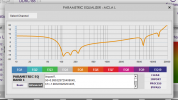I leave pretty much all of it as is, but shave the top of the higher peaks above say 9 KHz with phase linear EQ and checking the levels of energy stays the same when smoothed somewhat. Another trick is to get left and right output balance as close as you can, when summing it it can really hit + 6dB over the entire span except maybe on the far ends of the spectrum.
View attachment 240884
Left, right and sum, where I used one of the array's strong points in bass to fix the hole(s) in the other side.
Right is weak at 30 Hz, left has a dip at 70 Hz. This probably is heavily smoothed 1/3th.
Phase is corrected to follow the frequency curve (minimum phase), resulting in this as a stereo sum at the listening spot:
View attachment 240886
This only works if the first reflections are absorbed by quite a lot though. Don't try it when there's bare walls left and right of the speakers or close to the back of the listening position.

